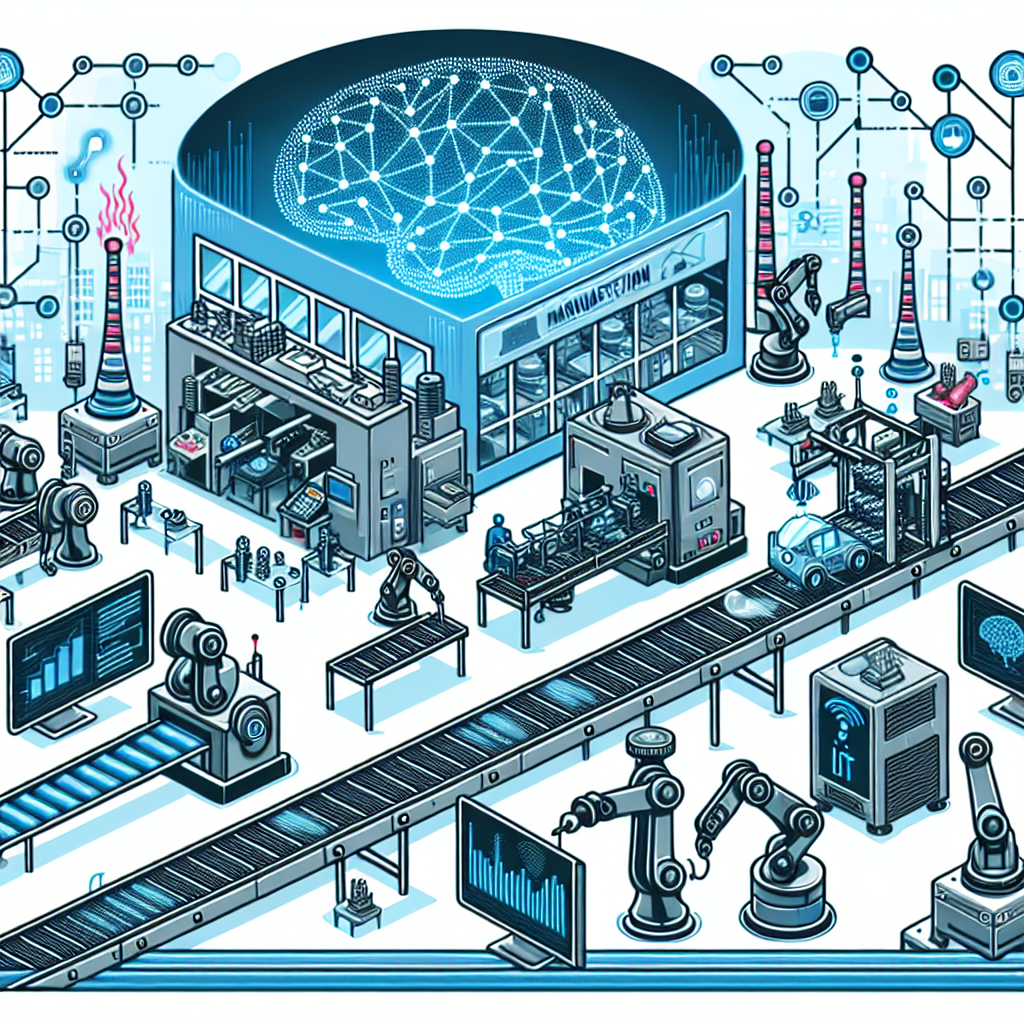The Integration of AI and IoT in Manufacturing
In recent years, the integration of Artificial Intelligence (AI) and Internet of Things (IoT) technologies has revolutionized the manufacturing industry. AI and IoT have opened up new possibilities for optimizing production processes, reducing costs, and improving overall efficiency. This article will explore the integration of AI and IoT in manufacturing, its benefits, challenges, and future trends.
What is AI and IoT in Manufacturing?
AI refers to the simulation of human intelligence processes by machines, including learning, reasoning, and self-correction. IoT, on the other hand, refers to the network of physical devices, vehicles, home appliances, and other items embedded with sensors, software, and connectivity that enable these objects to connect and exchange data.
In manufacturing, AI and IoT are used together to enhance automation, improve decision-making processes, and drive innovation. By combining AI algorithms with IoT sensors and devices, manufacturers can collect and analyze vast amounts of data in real-time to optimize production processes and make informed decisions.
Benefits of AI and IoT in Manufacturing
The integration of AI and IoT in manufacturing offers a wide range of benefits, including:
1. Predictive Maintenance: AI algorithms can analyze data from IoT sensors to predict when machines are likely to fail, allowing manufacturers to perform maintenance before a breakdown occurs. This helps to reduce downtime, increase productivity, and extend the lifespan of equipment.
2. Quality Control: AI-powered image recognition systems can inspect products for defects with greater accuracy and speed than human workers. IoT sensors can also track the production process in real-time, allowing manufacturers to identify and address quality issues quickly.
3. Inventory Management: IoT sensors can monitor inventory levels in real-time and send automated alerts when supplies need to be replenished. AI algorithms can also analyze historical data to predict demand and optimize inventory levels.
4. Energy Efficiency: AI algorithms can analyze energy consumption data from IoT sensors to identify opportunities for energy savings. Manufacturers can use this information to optimize energy usage, reduce costs, and minimize their environmental impact.
5. Supply Chain Optimization: AI and IoT technologies can track the movement of raw materials, components, and finished products throughout the supply chain. Manufacturers can use this data to optimize logistics, reduce lead times, and improve overall efficiency.
Challenges of AI and IoT in Manufacturing
While the integration of AI and IoT in manufacturing offers numerous benefits, there are also challenges that need to be addressed, including:
1. Data Security: The vast amount of data generated by IoT sensors and devices can be a target for cyber-attacks. Manufacturers need to implement robust security measures to protect sensitive data and prevent unauthorized access.
2. Compatibility Issues: Integrating AI and IoT technologies with existing systems and equipment can be challenging. Manufacturers may need to invest in new hardware, software, and training to ensure compatibility and maximize the benefits of AI and IoT.
3. Scalability: As manufacturing processes become more complex and data-intensive, scalability becomes a concern. Manufacturers need to ensure that their AI and IoT systems can handle increasing volumes of data and adapt to changing production requirements.
4. Skills Gap: Implementing AI and IoT technologies in manufacturing requires specialized skills and knowledge. Manufacturers may need to invest in training programs to upskill their workforce and ensure that employees can effectively use and maintain these technologies.
Future Trends in AI and IoT in Manufacturing
The integration of AI and IoT in manufacturing is expected to continue to evolve in the coming years, with several key trends shaping the industry:
1. Edge Computing: Edge computing, which involves processing data closer to the source (e.g., IoT devices), is becoming increasingly important in manufacturing. By processing data locally, manufacturers can reduce latency, improve reliability, and optimize bandwidth usage.
2. Autonomous Manufacturing: AI-powered robots and machines are increasingly being used in manufacturing to perform tasks autonomously. These autonomous systems can work faster, more accurately, and with greater flexibility than traditional manufacturing processes.
3. Digital Twins: Digital twins are virtual replicas of physical assets, processes, or systems that can be used to monitor, analyze, and optimize performance. Manufacturers are using digital twins to simulate production processes, predict maintenance issues, and improve efficiency.
4. AI-driven Design: AI algorithms are being used to optimize product design and development processes. By analyzing data from IoT sensors and other sources, manufacturers can create products that are more efficient, cost-effective, and tailored to customer needs.
5. Sustainability: AI and IoT technologies are helping manufacturers to reduce their environmental impact by optimizing energy usage, minimizing waste, and improving resource efficiency. Sustainable manufacturing practices are becoming increasingly important as companies strive to meet environmental goals and regulatory requirements.
FAQs
Q: How can AI and IoT improve production efficiency in manufacturing?
A: AI and IoT technologies can improve production efficiency in manufacturing by optimizing processes, reducing downtime, enhancing quality control, and optimizing resource usage.
Q: What are the key challenges of integrating AI and IoT in manufacturing?
A: Key challenges include data security, compatibility issues, scalability, and the skills gap. Manufacturers need to address these challenges to maximize the benefits of AI and IoT technologies.
Q: What are some of the future trends in AI and IoT in manufacturing?
A: Future trends include edge computing, autonomous manufacturing, digital twins, AI-driven design, and sustainability. These trends are shaping the future of manufacturing and driving innovation in the industry.
Conclusion
The integration of AI and IoT in manufacturing is transforming the industry by optimizing production processes, improving efficiency, and driving innovation. By leveraging the power of AI algorithms and IoT sensors, manufacturers can collect and analyze vast amounts of data in real-time to make informed decisions and optimize their operations. While there are challenges to overcome, such as data security and compatibility issues, the benefits of AI and IoT in manufacturing are undeniable. As the industry continues to evolve, manufacturers will need to adapt to new technologies, trends, and opportunities to stay competitive in a rapidly changing market.

